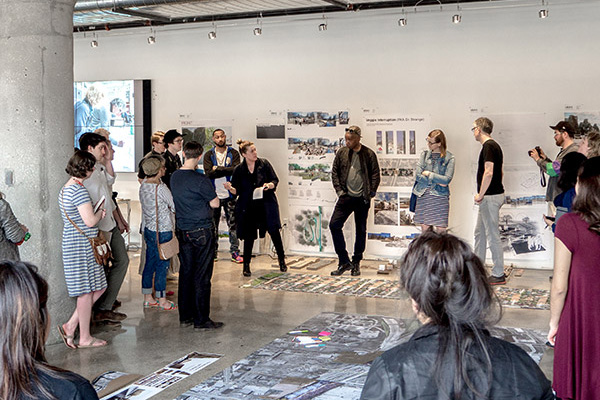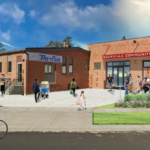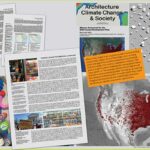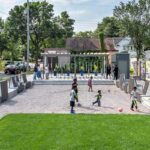On The Urban Edge
From Waste to Wonder
The 2017 Urban Edge Award
From Waste to Wonder: Working with What Remains
Every two years the School of Architecture & Urban Planning at the University of Wisconsin–Milwaukee presents The Urban Edge Award—a biennial prize that recognizes excellence in urban design and the ability of individuals to create major, positive change within the public realm. This award honors internationally recognized design professionals who bring fresh, innovative, and effective thinking with a focus on urbanism and landscape to the field of design. Traditionally The Urban Edge Award has been given to a single individual or office, but in the spirit of interdisciplinary collaboration, Assistant Professor Nikole Bouchard shook things up this year by inviting six design professionals to conduct three design workshops with SARUP students throughout the 2017 spring semester.
The theme of this year’s Urban Edge Award was “From Waste to Wonder—Working with What Remains.” The goal of the three design workshops was to create a variety of design projects that addressed selected urban sites, situations, and social inequities that are specific to Milwaukee, but similar to scenarios in post-industrial cities throughout America. Each design workshop had a unique theme, site, and cast of characters. The fifteen From Waste to Wonder seminar students developed design projects at a variety of scales that explored issues of urban vacancy, adaptive reuse, and productive landscapes. Students used the power of design to re-imagine a Milwaukee where cultural, social, economic, and environmental issues are foregrounded and fortified.
The Urban Edge Award design workshops culminated on Saturday, April 15th at Workshop Architects in Milwaukee with a public symposium and final review where the research and design projects were presented, discussed, and debated with the invited keynote speaker, Walter Hood, the six design workshop leaders, seminar students, faculty, and stakeholders.
Design Workshop No. 01:
Urban Vacancy & Milwaukee’s 30th Street Industrial Corridor
Milwaukee’s 30th Street industrial corridor is the quintessential post-industrial city site. As in most rustbelt cities, de-industrialization began in the 1970s, resulting in an economic downturn that has left Milwaukee’s north side plagued with issues of unemployment and abandonment. Today nearly 100 acres of the corridor are vacant with pockets of blight scattered across the terrain.
The Urban Edge Award Design Workshop No. 01 in January of 2017 brought Brooklyn-based artist Olalekan Jeyifous of Vigilism and Detroit-based designer and academic Catie Newell of the University of Michigan to SARUP to work with students over a four-day design charrette. The goal was to develop design proposals that address the pressing issues of urban vacancy that surround Milwaukee’s 30th Street industrial corridor. Students were asked to re-appropriate and reconfigure existing architectural, mechanical, political, and cultural structures to produce fantastical projects that are inspiring, critical, and cautionary.
Design Workshop No. 01 Project Award /
Valerie Davis, Lauralena Valdivia & Tommy Yang
Design Workshop No. 02:
Adaptive Re-Use & Milwaukee’s Kinnickinnic River Corridor
Milwaukee’s Kinnickinnic River corridor was once a vibrant and lively waterway that was lined with native trees and filled with freshwater springs, fishing hot spots, and thriving flora and fauna. In the 1960’s the riverbed was channelized, leaving a negative impact on the ecological and urban landscapes that surround it.
The Urban Edge Award Design Workshop No. 02 in February of 2017 brought Cambridge-based landscape designer Fionn Byrne of Harvard University and Buffalo-based architect and academic Joyce Hwang of SUNY Buffalo to SARUP to explore adaptive reuse ideas with students over another four-day design charrette. The goal was to consider spaces and situations that might not necessarily be seen as opportunities for design. Students were encouraged to develop design ideas that confront the contemporary ecological conditions of the Kinnickinnic River corridor. Design proposals incorporated wildlife habitats, responded to social inequities, and pondered the potential adaptive reuse of the acquired and soon-to-be-razed residences.
Design Workshop No. 02 Project Award /
Jarincy Flores Rodriguez, Jeremiah Huth & Matt Winder
Design Workshop No. 03:
Productive Landscapes & Milwaukee’s Menomonee Valley
The confluence of the Milwaukee and Menomonee Rivers sits at the eastern end of the Menomonee Valley—a four-mile long and half-mile wide swath of land that cuts directly through the center of downtown. The valley was once rich with natural resources, rice, grasses, and cattails, but in the mid-1800s the first railroad lines were laid. This transformed the natural wonder into a Wisconsin wasteland. Heavy industry came and went, leaving the valley to be nothing but a toxic urban embarrassment.
The Urban Edge Award Design Workshop No. 03 in March of 2017 brought Cambridge-based landscape designer and architect Sergio Lopez-Pineiro of Harvard University and Ithaca-based architect and academic Aleksandr Mergold of Cornell University to SARUP to develop design proposals with students over the third and final four-day design charrette. Students were asked to ideate on making Milwaukee’s post-industrial environments productive landscapes once again. Students considered the Menomonee Valley as an “Urban Attic.” They saw voids as opportunities for the unplanned and the unpredictable to emerge. Abandoned building types and vacant spaces were arranged within a designed framework to reconnect the severed spaces within the urban fabric.
Design Workshop No. 03 Project Award /
Hayden Newton, Leeann Wacker & John Young
Public Symposium & Final Review:
With Keynote Speaker and Design Critic Walter Hood
On Saturday, April 15th Walter Hood, founder and creative director of Hood Design Studio and Professor of Landscape Architecture, Environmental Planning and Urban Design at UC-Berkeley, joined The Urban Edge Award participants as the keynote speaker and design critic for the public symposium and final review. Walter Hood is an artist, designer, and educator whose work engages research, art, planning, landscape and urban design to unveil the emergent beauty, strangeness, subjectivity, and idiosyncrasies of specific places. As a pedagogue and a practitioner, Walter is committed to the development of environments that reflect their place and time specifically through the way in which people inhabit various geographies. His work engages oral histories and analyzes physical, environmental, and social patterns to uncover familiar and untold stories.
Recently Walter Hood was selected to design a new linear park that bridges Milwaukee’s Harambee and Riverwest neighborhoods as part of the Beerline Trail Neighborhood Development Project. The goal of this project is to sustain and enrich the lives of the people in Harambee and Riverwest by promoting health, well-being, and prosperity through the increased circulation of resources, voices, ideas, labor, and creativity. Walter brought these related ideas and insights to the conversation as he discussed the design research and work that was developed throughout the three Urban Edge Award design workshops with seminar students, faculty, and stakeholders.
Working With What Remains
The Urban Edge Award: From Waste to Wonder—Working with What Remains design workshops considered how working with what remains, at multiple scales, can be imaginative, innovative, inspiring, and intellectually stimulating. As pedagogues and practitioners, it’s our responsibility to face these issues head-on. We must question our preconceived notions of waste and develop design ideas that strive to conserve resources and challenge the imagination. These design proposals are not self-referential, but instead they engage a wide-range of audiences, including artists, architects, industrial designers, landscape architects, ecologists, environmentalists, anthropologists, and garbologists. They are examples of thoughtful, creative, and collaborative design projects that are rooted in reality but reach for the radical.
Walter Hood is the Creative Director and Founder of Hood Design Studio in Oakland, CA. He is also a professor at the University of California, Berkeley and lectures on professional and theoretical projects nationally and internationally. Hood Design Studio is tripartite practice, working across art + fabrication, design + landscape, and research + urbanism. The resulting urban spaces and their objects act as public sculpture, creating new apertures through which to see the surrounding emergent beauty, strangeness, and idiosyncrasies. The Studio’s award winning work has been featured in publications including Dwell, The Wall Street Journal, The New York Times, Fast Company, Architectural Digest, Places Journal, and Landscape Architecture Magazine.
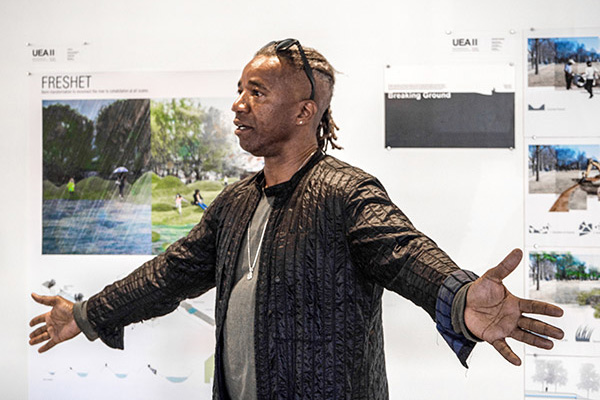

Valerie Davis, Lauralena Valdivia & Tommy Yang
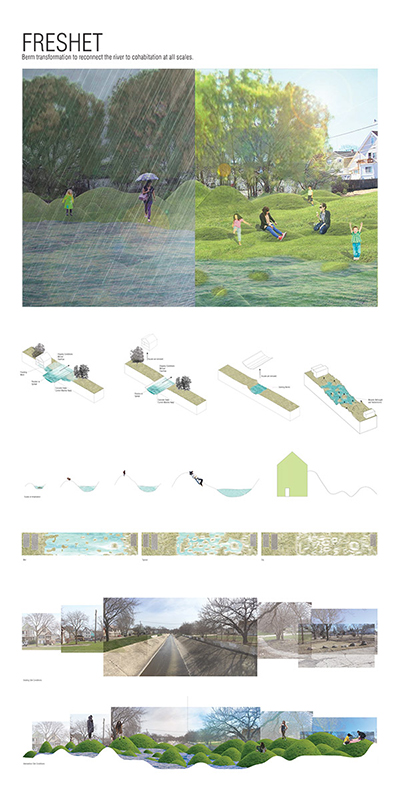
Jarincy Flores Rodriguez, Jeremiah Huth & Matt Winder

Hayden Newton, Leeann Wacker & John Young
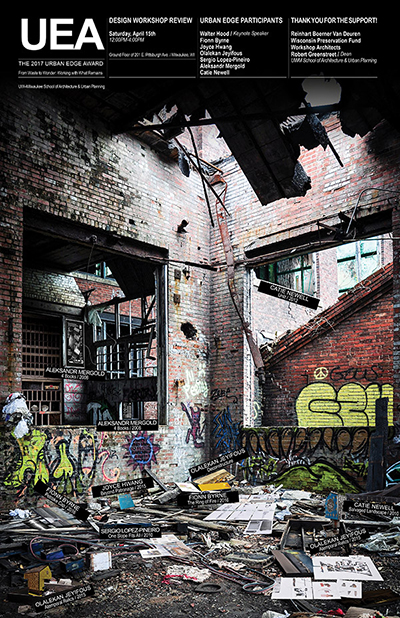
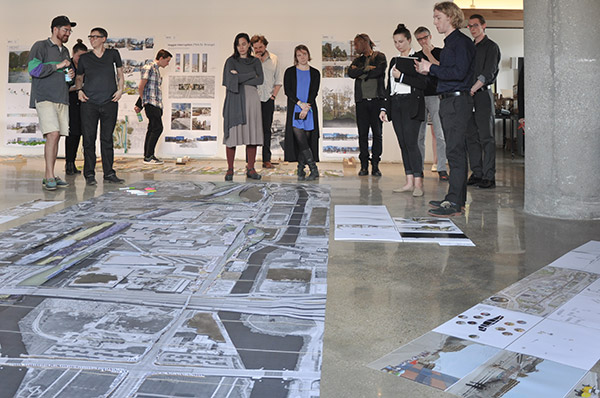
Graduate Student Bill Noelck presents his team’s Design Workshop No.03 design proposal for Milwaukee’s Menomenee Valley.
